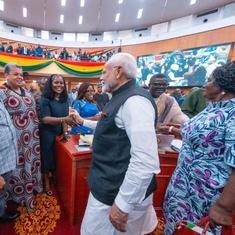Arvind Subramanian is not backing down.
A month ago, India’s former Chief Economic Adviser Arvind Subramanian set the cat among the proverbial pigeons with a paper arguing that India’s Gross Domestic Product numbers are over-stated by as much as 2.5 percentage points. The paper received a great deal of support, but was also dismissed by the government’s economic advisory council and its supporters, some of whom questioned Subramanian’s motivations.
Now, Subramanian has released a follow-up paper that doubles down on the conclusions he drew in the first one, as well as a key demand: India needs a complete re-look at its GDP calculation methodology “to see how the problems that seem to have resulted in an overestimation of GDP growth can be addressed”.
Will the government continue to ignore his position?
The background
Analysts and experts have been questioning the Indian Gross Domestic Product figures ever since the methodology for calculating it was updated in 2015, contending that the numbers were both unreliable and implausibly favourable to the current government.
Subramanian went further.
For one, he couldn’t be dismissed as being motivated by politics. Subramanian was handpicked by Prime Minister Narendra Modi’s government to give it advice, and spent years as one of its primary economic thinkers. For another, the former Chief Economic Adviser put a number to it: his paper said that India’s growth rate for 2011-2017 had been overestimated by as much as 2.5 percentage points.
In other words, if the average for that time – encompassing both the Congress-led government and the first three of the Modi years – was officially 7%, Subramanian insisted that it was closer to 4.5%. The paper called for “the entire methodology and implementation for GDP estimation [to be] revisited by an independent task force, comprising both national and international experts, with impeccable technical credentials and demonstrable stature”.
Read a full explainer on that paper here.
The implication of course, was that unless the government carried out this process – or at least acknowledged the need for a relook – India’s economic figures should not be trusted.
The responses
The paper got a lot of reactions, from across the political and economist spectrum – collected here. Although the government itself did not reply to Subramanian’s claims, it let the Prime Minister’s Economic Advisory Council do this instead. The council put out a response paper that called Subramanian’s conclusions “hurried”, “weak” and “broad”. It also sought to chasten the former Chief Economic Adviser for demoralising the “army of government economists and statisticians” that he once worked with.
Others also poked holes in Subramanian’s argument, saying that he had picked flawed metrics to measure GDP, that no one calculated GDP figures the way he did, and that his analysis was cherry-picked and would not stand-up to closer scrutiny. But those weren’t the only responses.
Numerous economists and analysts also agreed with Subramanian. Some said that while they would not endorse his 2.5 percentage point number, they too believed India’s GDP figures were over-estimated and work would have to be done to figure out by how much.
Follow-up
In the fresh paper from this week, and a Powerpoint presentation at the India Policy Forum, Subramanian addresses a number of the criticisms of his paper.
He first takes on the question of whether he was only raising the issue now, after having left government. Subramanian points out that in the Economic Survey tabled in Parliament in 2015, he called the growth figure for that year “puzzling.” In the one from 2017, the Survey finds that no other country had achieved growth at the rates India was claiming with such weak actual indicators.
“Thus, starting early on and throughout my tenure as CEA, my team and I continually grappled with the issue of GDP measurement and the possible problems with it, expressing our concerns in the relevant documents,” Subramanian writes. “The new GDP paper is consequently just another step in attempting to resolve the original puzzle.”
He then takes on the obvious criticisms, like those who claimed that no one calculates GDP the way he did. Subramanian points out that the underlying data are only available to India’s Central Statistical Office, and that what he was trying to do was run a smell test on their conclusions about GDP growth.
“Since the underlying data are not available publicly, nobody outside the CSO can estimate GDP...,” he said. “Outsiders can only check to see whether the GDP estimates are plausible, broadly satisfying some macro-consistency checks. That is what my GDP paper attempted to do: not to estimate but to cross-check and validate the CSO figures.”
At this point, Subramanian reiterates the fundamental point of his paper. Between 2002-2011 India’s 7.5% GDP growth fits in with indicators such as exports, investment and so on, and corresponds to similar numbers from other countries in the same range.

But after 2011, a number of these indicators fall off a cliff, growing much slower than they did in the previous decade. Yet, by and large, under the new GDP methodology, India’s growth figures appear to only be marginally slower, which is what Subramanian calls the “central puzzle”.

This remains the primary underpinning of his paper, and the reason for Subramanian’s belief that India’s GDP numbers are overestimated and need to be re-examined.
Same conclusions
The rest of the follow-up paper shows attempts to double-check even these conclusions, to see whether the numbers or dates were cherry picked, or whether there were some indicators that would offer a plausible explanation for why things seem so off.
He also addresses one big critique, that if India was only growing at 4.5% – a redux of the so-called “Hindu rate of growth” of the 1980s – then the economy would feel much worse. Subramanian argues that this is mistaken, because India’s economy has grown much larger since then even as population growth has slowed, which means 4.5% today is almost double the old “Hindu” rate of growth.
“India, at 4.5 percent real GDP growth, would be the second-fastest growing economy in the 2012-2016 period, just as it was in the 10 years preceding,” he writes. “Indeed, India’s 4.5 percent is well ahead of the third fastest growing economy, Korea which grew at 2.9 percent. To be sure, a pace of 4.5 percent GDP growth for India would represent some under-performance because there are other countries that have been growing rapidly such as Bangladesh, Vietnam etc. but it is far from being a disaster.”
Ultimately, Subramanian returns to the same conclusion as before.
“Each individual piece of evidence could possibly be explained by appealing to reasons other than measurement changes. But the cumulative and mutually consistent nature of this evidence makes it difficult for non-measurement related reasons to explain this collection of empirical facts,” he writes. “Where do we go from here? The most important task is to re-visit the GDP methodology, to see how the problems that seem to have resulted in an overestimation of GDP growth can be addressed.”
The government has so far not bothered to do this, with the Economic Survey and the Budget making no mention of questions about GDP data over the last month. But with Subramanian, an economist with tremendous clout globally, reiterating his stand, can it afford to continue ignoring him?










